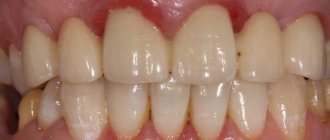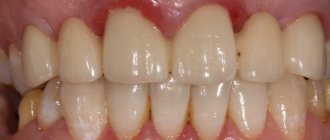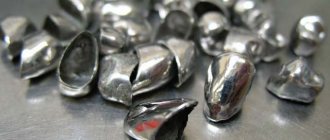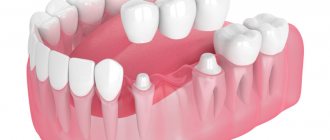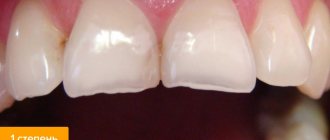Why is temporary filling needed?
The need to use filling material is determined by the dentist. The installation of a temporary filling is prescribed by a doctor in the following cases:
- Carrying out diagnostics. When treating a patient with deep caries, a specialist is not always able to determine the extent of tissue damage. The doctor cleans the tooth cavity and places filling material. If the neurovascular bundle is not inflamed, then after the procedure the person will not experience pain. If the dental nerve and surrounding tissues are damaged, preliminary treatment will be required.
- Removal of the neurovascular bundle. In some cases, nerve sacrifice is required before removal. To do this, the dentist puts a specialized paste into the tooth cavity. After a certain period of time, the specialist removes the pulp and fills the tooth cavity with permanent filling material.
- Dental prosthetics. The dentist prepares teeth for prosthetics. To ensure that the root canals are protected from food and pathogenic bacteria during manufacturing, the specialist places a temporary filling material into the tooth cavity.
- Treatment of diseases. After treatment, the dentist places medications into the tooth cavity. After a certain period of time, the specialist removes the temporary filling and installs a permanent filling.
Temporary filling. What happens if you go with a temporary filling?
A temporary filling is placed on a tooth most often during root canal treatment (treatment of pulpitis or periodontitis - cysts). The main functions of a temporary filling are to isolate the medicinal material introduced into the root canals, prevent microbes and food particles from entering the tooth, temporarily restore the chewing function of the tooth, and strengthen the thinned walls of the tooth. The period for which a temporary filling is placed depends on what kind of medicine is in the root canals and what the initial diagnosis is. In some cases, the medicinal substance has strict restrictions on the period of application - for example, devitalizing pastes (arsenic analogues), which are injected into the tooth for 1-2 weeks in case of acute pulpitis, before removing the nerve and cleaning the root canals - in such cases, proceed with a temporary filling maybe a few days, a week at most. If you leave the devitalizing paste for a longer period, it will penetrate into the tissue surrounding the tooth and cause necrosis and inflammation of the periodontium - periodontitis.
If an antiseptic drug, for example, based on iodoform or calcium, is introduced into the root canals, then going with it is not so dangerous, but dentists still do not recommend leaving it for more than one month (in rare cases - three months), because when left in the canals for a long time, it dehydrates the hard tissues of the tooth, making the tooth more fragile. In addition, over time, the temporary filling may wear out, chip, lose its tightness (and the patient may not even notice it), while the medicinal substance will be washed out of the root canals, and an infection from the oral cavity will get inside the tooth, aggravating the problem (in this case, all Previous treatment and installation of a temporary filling will have to be repeated again).
If the root canals have already been filled with permanent material, and there is still a temporary filling on top, then it is also recommended to complete the treatment and restore the crown part of the tooth with a permanent filling, inlay or artificial crown within 1–3 months, because a dead tooth is very fragile, its walls can easily break off, the tooth can crack, and a temporary filling does not protect it from such situations. And if the temporary filling falls out or becomes leaky, then even microbes can leak into the root canals filled with permanent material, triggering the development of periodontitis (granulomas or cysts on the root of the tooth).
In any case, after installing a temporary filling, it is important to ask the dentist when it is necessary to continue treatment and clarify the maximum possible time for the temporary filling to remain in the tooth (in case of unforeseen circumstances and the impossibility of a visit on the appointed day).
Material requirements
To install a temporary filling, a specialized material is used that can be easily removed by the dentist if necessary. The composition for temporary filling must meet the following requirements:
- X-ray resistant. To check the correctness of the filling, the dentist prescribes an x-ray examination. The image allows you to timely identify the presence of cracks in the filling material and eliminate them.
- Good grip on the surface. It is necessary to exclude the formation of microcracks or incomplete adhesion of the material to the tooth tissue. Violation of this rule may result in medication entering the oral cavity.
- Elasticity. The material should easily fill the pores formed in the tooth tissue.
- Strength. The material is installed by the dentist for a certain period of time. When eating, the filling is subjected to high stress. In this regard, the seal must be resistant to mechanical damage.
- Harmlessness. The filling should not cause allergic reactions or negatively affect human health.
- Easy to remove. At your follow-up appointment, the doctor quickly removes the temporary filling.
A mandatory requirement for temporary material is a high curing speed. The filling completely hardens in 2 – 3 hours.
Types of temporary fillings
Fillings differ in the material from which they are made. There are the following types of temporary fillings:
- water dentin. Consists of powder with zinc sulfate and oxide with an admixture of kaolin. The components are mixed with distilled water to form a cement substance. Used in the treatment of baby teeth;
- dentin paste. It has an oil base and is available in a ready-to-use form. This substance hardens in 2-3 hours, but has antiseptic properties. Used to seal medicine;
- cements: polycarboxylate, zinc eugenol and zinc phosphate. Used for teeth that bear increased chewing load (molars, premolars);
- polymer materials with a rubber-like consistency. They are characterized by high elasticity and high-quality adhesion to the dental walls. They belong to light-curing pastes, suitable for temporary restorations and fixation of temporary inlays.
- Cimpat N Septodont is an instant hardening paste that contains zinc, is non-toxic, and does not cause allergies. Used as a temporary sealant or as a composite underlay.
Provicol VOCO – a calcium-containing material that helps restore enamel, used to close small cavities;
What can happen after installing a temporary filling?
In some cases, patients experience pain after placing temporary filling material into the tooth cavity. Mild pain during the first 5 days after the intervention is considered normal. If pain intensifies, you should immediately consult a doctor. Violation of this rule can lead to the development of various diseases and tooth loss.
It is normal to have a smell or taste of medication in the mouth after the procedure. The sudden appearance of a strong smell or taste of medicines indicates depressurization of the filling and leaching of medicines with saliva from the tooth cavity. Some drugs, if they enter the oral cavity, can have a negative effect on the human body. If such signs appear, you should immediately contact a specialist.
Swelling of the gums, darkening of tooth enamel, and the appearance of bad breath indicate the development of diseases. If symptoms appear, you should contact your dentist immediately. The doctor will remove the filling material and carry out diagnostic measures. You may need to contact your dentist if the filling breaks. Failure to visit a specialist in a timely manner will result in food particles and bacteria entering the tooth cavity.
Discomfort and inconvenience after installation of a filling
Immediately after a filling, the cause of discomfort in the mouth may be the lack of treatment before the filling is placed, and having a healthy tooth can create an unusual feeling of something new.
discomfort conditions of a filled tooth are a reason to urgently consult a doctor
- Foreign body sensation requires diagnosis to determine the origin of the discomfort. If you ignore such a symptom, there is a possibility of developing more complex inflammatory processes.
- A feeling of roughness and scratching indicates insufficient polishing of the filling. The defect is quickly eliminated with a second visit to the doctor and additional polishing to a comfortable state.
- An incorrect bite indicates an incorrect formation of the shape of the filling, which is measured in fractions of millimeters. The reason for this situation is the fact that anesthesia, which continues for some time after the filling procedure, does not make it possible to fully feel the shape of the tooth. Numbness of the jaw under the influence of anesthetics makes it difficult to report the presence of discomfort in the dentist’s office immediately after the filling is installed. The shape of the filling is quickly corrected by filing during a second visit to the doctor.
- A tightening tension in the jaw, a feeling of pressure inside the filled tooth, and discomfort when closing the teeth are created by an oversized filling. This is caused by increased pressure on the tooth walls and nerve endings. Possible consequences range from microdestruction of the dental wall to bacterial inflammation, from malocclusion to diseases of the temporomandibular joint.
- An incorrectly shaped filling can also create additional trauma to the oral mucosa when wearing orthopedic structures.
- Some time after the filling is installed, an increased reaction to irritants even without them (sour, cold, etc.) goes away with the correct selection of paste and other means. A sensitive reaction can be triggered by overdrying of the dentin during filling or loss of tightness of the filling material. To get rid of unpleasant sensations, the intervention of a doctor is necessary.
- Uncomfortable sensations during eating and the entry of food particles into the interdental spaces require the restoration of the interdental contact point, which determines the anatomical correspondence of the filled tooth with the rest of the teeth.
- An allergy to the components of the filling material is sometimes accompanied by bitterness in the mouth, pain, and skin reactions: itching, rash. In such a situation, the filling is replaced with a material that does not cause an individual reaction.
Dental specialists at Die Hard will individually consider the causes of discomfort after installing a filling and eliminate them, providing you with the comfort of healthy teeth. Dentistry in Moscow will cope with even the most complex inconveniences that appear after filling.
How long can you walk with a temporary filling?
The material used for temporary filling is highly durable. The filling does not break down for a long time. The specialist determines the period of wearing temporary filling material based on the nature and degree of neglect of the disease. The duration of wearing the filling is individual for each patient.
At the end of the established period, the person must immediately contact a specialist. An increase in the time period can lead to the development of diseases. In some cases, the filling may crumble at the end of its period, and the drug will negatively affect the patient’s body.
How long can a temporary filling be used?
Many patients have a reasonable question: how long can they walk with a temporary filling and how long can it stay in the tooth cavity.
Depending on the indications for treatment and its composition, the installation period for a temporary filling can range from 1 day to six months. The filling will not last for more than 6 months, so your visit to the dental clinic should be planned in advance (in case of long trips or business trips).
If a temporary filling falls out, you should immediately seek advice from your doctor. Based on the examination, the dentist can make one of two decisions: if the treatment is at an incomplete stage, the doctor will place another temporary filling; A permanent filling will be placed if the medication wears off.
Be that as it may, “postponing the matter” is fraught with serious problems. Before visiting a specialist, you should thoroughly rinse your mouth after eating to avoid the entry of pathogenic bacteria into the open cavity, which can cause inflammation.
The cost of installing a temporary filling directly depends on its composition and the specific dental clinic and will range from 350 to 650 rubles.
This article is for informational purposes only, please consult your doctor for details! Ask your doctor about contraindications and side effects.

